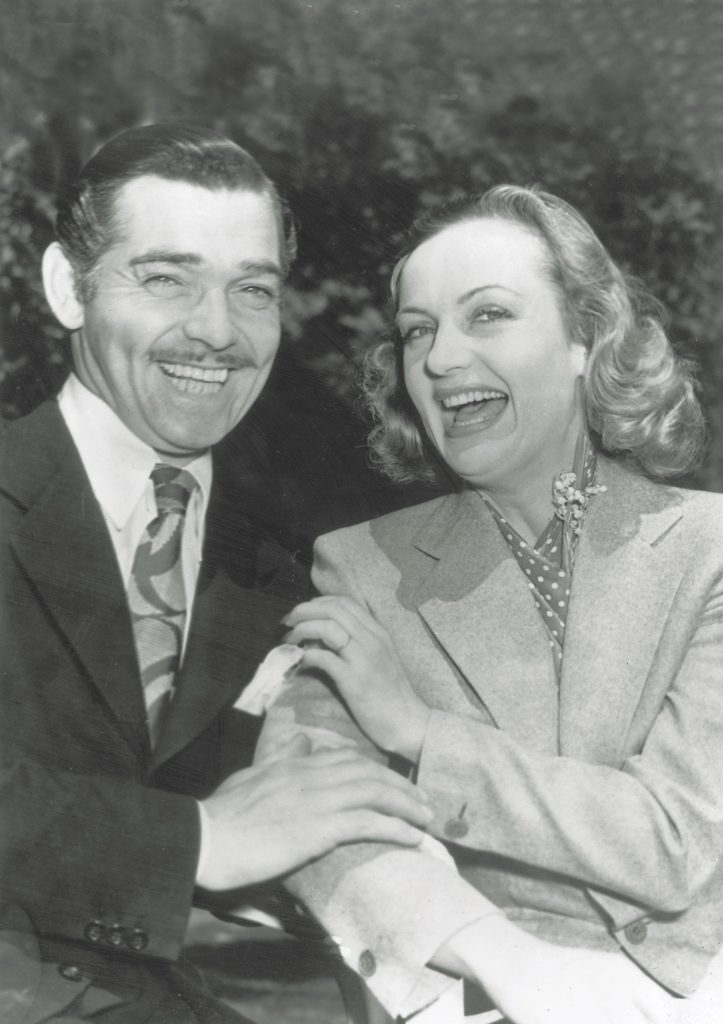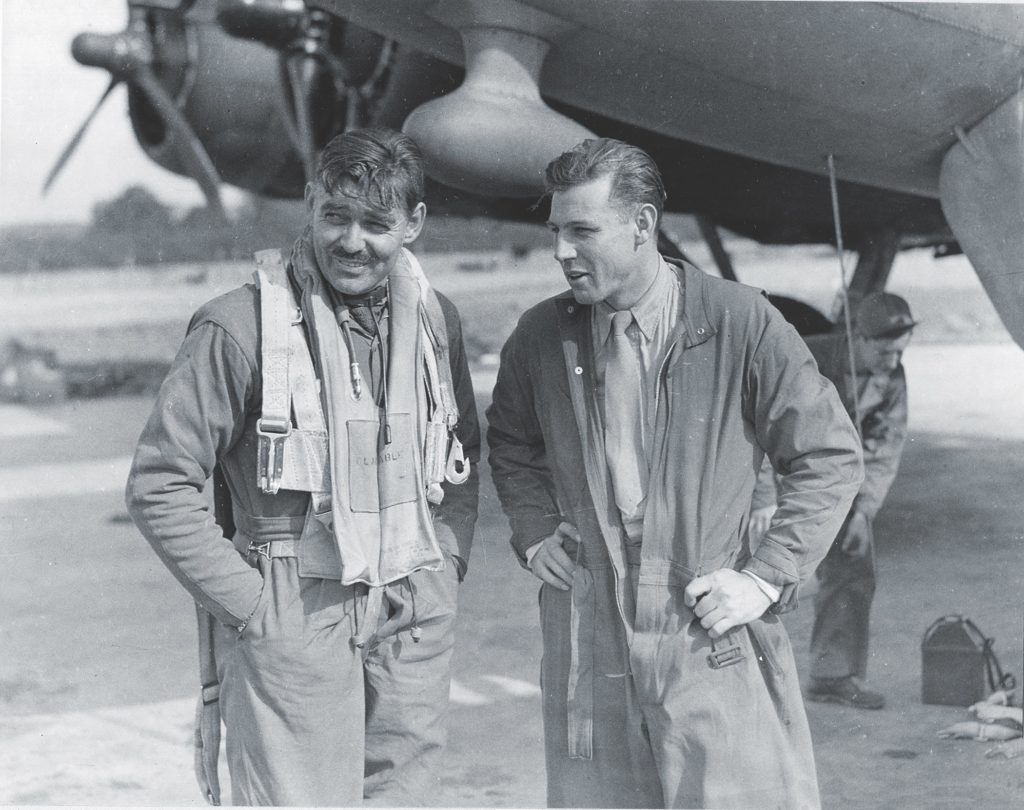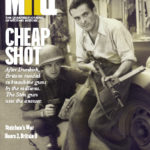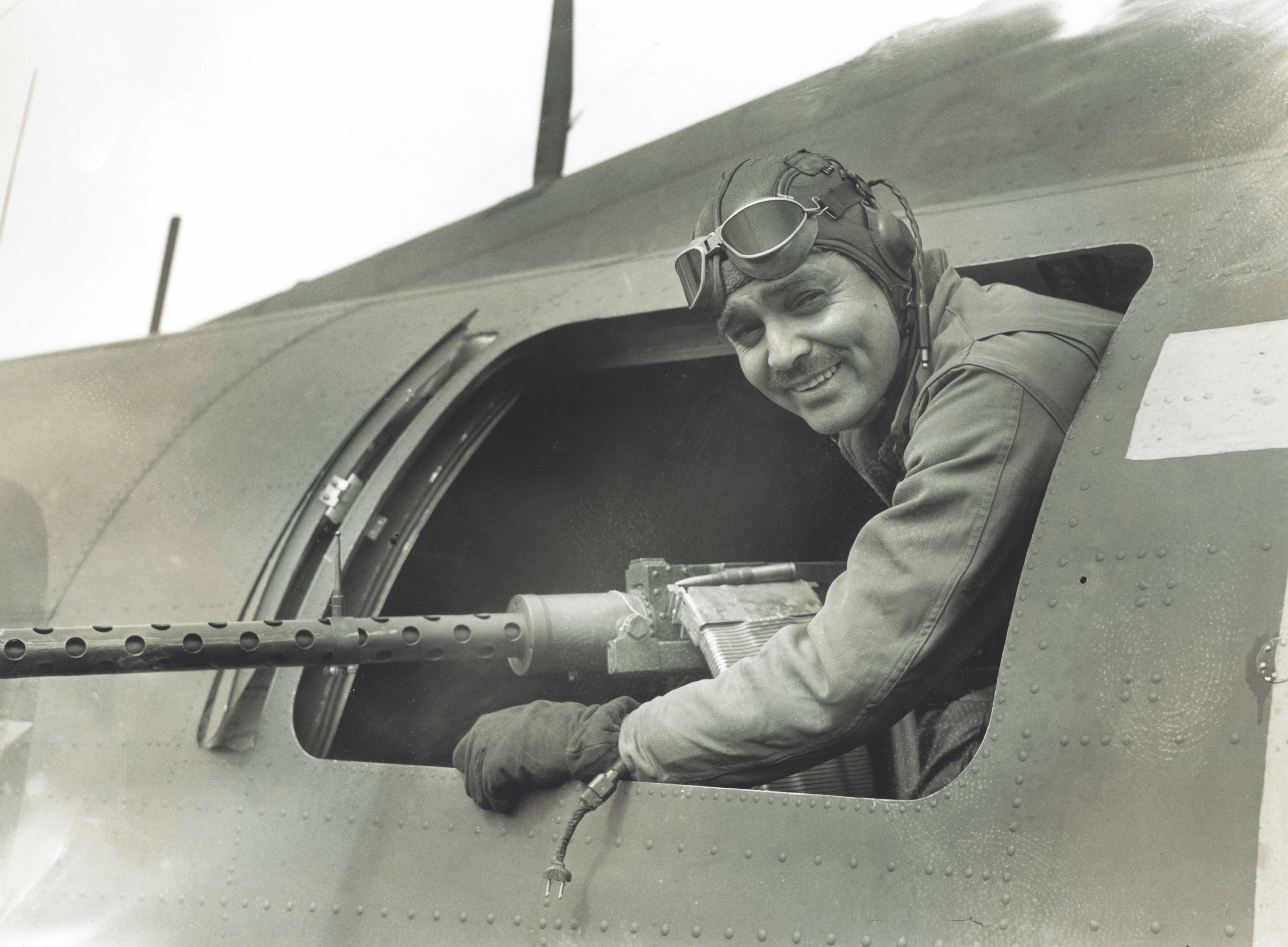In 1942, disconsolate over his wife’s death, Clark Gable enlisted in the U.S. Army. Then he nearly lost his own life in the skies over Germany.
ON AUGUST 12, 1943, CLARK GABLE—HOLLYWOOD’S TOP LEADING MAN, the star of such box-office blockbusters as It Happened One Night and Gone with the Wind—nearly lost his life in the skies over Germany. As a captain in the U.S. Army Air Forces, Gable was flying in a Boeing B-17F Flying Fortress named Ain’t It Gruesome. He had brought along a 16-millimeter movie camera loaded with color film as part of his assignment to make a recruiting film.
At 42, Gable was a generation older than most of the crewmen he accompanied into combat. Nevertheless, he was there out of duty—not so much to his country, but to his late wife, actress Carole Lombard, who had pushed him to sign up just before her own death in a plane crash. The army brass didn’t have much use for the aging star as a gunner, his chosen specialty, but they did want to exploit Gable’s celebrity appeal. So there he was, perched precariously in the plane’s top turret, wedged behind the gunner to get a better view. That’s when the B-17’s radio operator, Master Sergeant Fletcher Cupp, heard a noise that sounded something like a dropped tin can.
A German shell had penetrated the aircraft and come up through the flight deck. As was later determined from the angle of the hole, the 20mm shell missed Gable’s head by inches. It wasn’t until after the bomber landed that Gable realized the shell had taken off the heel of one of his boots as it passed without exploding through the aircraft.
Afterward Gable seemed unfazed. “Of course, I was scared,” he said. “Any shot that hits the plane you’re in is plenty close enough.”
Gable—rugged, dark-haired, with a dapper moustache he’d sported almost constantly since 1930—was one of many Hollywood stars who joined the U.S. military in World War II. Some, like Henry Fonda, who was awarded a Bronze Star for his service as a naval officer in the Pacific Theater, and James Stewart, a B-24 bomber pilot whose decorations included a Distinguished Flying Cross, had more celebrated careers in uniform. Other stars, like future president Ronald Reagan, whose poor eyesight restricted him to stateside service, served the country by making movies and newsreels designed to bolster public support for the war effort.
But Gable was the only one driven to serve by a grief so intense that some questioned whether his real purpose was not to help achieve victory but to be killed in action. And to get into combat, he had to overcome myriad obstacles, from his studio’s desire to keep him at home to his age, physical limitations, and lack of education, as well as army superiors’ aversion to putting Hollywood’s biggest star in harm’s way and risking his death or capture by the Nazis. Gable managed to surmount all of them—but at a cost.
FOR GABLE, THE WAR REALLY STARTED AT THE FOOT OF TABLE MOUNTAIN, an 8,500-foot peak southwest of Las Vegas, in January 1942. A friend had driven Gable there so he could glimpse the wreckage of a TWA airliner in which his wife and 21 other people had been killed. As Gable biographer Crystopher Spicer recounts, the handsome star simply stood there, staring into the distance for a long time, silent and disconsolate. When he returned to the couple’s ranch in the San Fernando Valley, he was so paralyzed by his sense of loss that he wandered the grounds aimlessly for days afterward.
Lombard had been a striking contrast to the easygoing, politically apathetic Gable. A fervent supporter of President Franklin D. Roosevelt and his policies, she had dragged Gable along to the White House to sit in on one of FDR’s famous fireside chat radio broadcasts in late 1940. Afterward, FDR had peppered Gable with questions about Gone with the Wind and told the couple that he needed Hollywood’s help in supporting preparations for America’s inevitable entrance into the war against Adolf Hitler. After the Japanese attacked Pearl Harbor, Lombard became an enthusiastic promoter of war bonds, and Gable became the chairman of a Hollywood committee that arranged for celebrities to visit military bases and hospitals.
But Lombard prodded Gable to do more. She wanted him to enlist in the military, even though he was well above draft age and reluctant to give up his luxurious civilian life. And Metro-Goldwyn-Mayer wasn’t eager to lose a big box-office star. So the studio cast him in a patriotic-themed film, Somewhere I’ll Find You, in which he played a war correspondent. Lombard, though, kept up the drumbeat. In the midst of her bond-selling tour, she sent him a telegram saying, “Hey, Pappy, you’d better get into this man’s army.” (“Pappy” was her nickname for Gable.)
After Lombard’s death, the message must have haunted Gable. The production of Somewhere I’ll Find You began in 1942 without him as he continued to grieve. Eventually, after a month, he was able to make it to the set to shoot his scenes, but he was a changed man, moody and somber. At night, he drank heavily. Studio executives offered him a chance to star in a motion picture about World War I flying ace Eddie Rickenbacker, but Gable wasn’t interested in pretending to be a combat hero. Instead, he decided that the only way to ease his pain was to fulfill his wife’s last wish. He informed MGM that he wouldn’t make more movies until after the war and went to see U.S. Army recruiters to offer his services.
The commander of the U.S. Army Air Forces, General Henry H. “Hap” Arnold, saw a way to make use of Gable. He needed recruits for the harrowing, risky job of serving as machine gunners on bomber flights. A promotional film made by one of Hollywood’s foremost icons of masculinity seemed like the perfect way to lure them in. All Gable had to do was get through officer candidate school so that he could run a filmmaking team in the army.

ON AUGUST, 1942, GABLE WENT TO A U.S. ARMY OFFICE IN DOWNTOWN LOS ANGELES to be inducted as a private. He then boarded a train for Florida to attend OCS at the Miami Beach Training Center. On the way, Gable must have felt some trepidation. Beneath all the glamour, he was a 40-something high-school dropout who had a drinking problem, suffered from hemorrhoids, and wore dentures. To avoid humiliating failure, he would have to keep up with younger, better educated men. But as a sign of his seriousness, when he got to Miami he shaved off his trademark mustache, letting a horde of waiting journalists watch.
Gable soon settled into a grueling regimen that began at 4:15 a.m. with reveille and a prebreakfast march, followed by hours of exercises, chores, and classwork, and then afternoon drills in full equipment in temperatures that soared above 100 degrees. Fainting in the heat would earn a demerit—and if it happened a second time, expulsion. “Mr. Gable is not a young chicken, and the heat here is really tough on him,” Gable’s roommate, Sergeant Hyman Grossman, wrote in a letter home. But Gable persevered. When the marches gave him blisters the size of quarters, he quietly asked another recruit for a needle to lance them rather than call attention to himself by asking a medic for help. When other recruits treated him warily, Gable broke the tension by yanking out his dentures in the washroom and waving them around. “Look at the King of Hollywood!” he called out with a self-deprecating laugh. “Sure looks like the Jack now, doesn’t he?” After that, the other men warmed to him.
Gable’s presence at the training center attracted scores of female fans, who gathered to catch a glimpse of him when he marched to mess hall. Some even tried to sneak into the hotel that had been converted into a barracks for him and other officer candidates. But Gable didn’t pay much heed. He was too busy struggling to keep up with the lectures. Fortunately, his instructors passed out mimeographed sheets that he would spend all night committing to memory, as if he were learning a script. In the end, he did surprisingly well, finishing in the top quarter of his 2,600-man class. His classmates asked Gable to give a speech at their commissioning ceremony. “The important thing, the proud thing, that I’ve learned about us is that we’re men,” he reportedly said that day. “No one could say a finer thing about us….Multiply us by millions of other Americans, and you have what it takes to win the war, and what will cost us victory if we don’t have it.”
AFTER TRAINING AS AN AERIAL GUNNER AT FORT GEORGE WRIGHT IN SPOKANE, Washington, Gable was sent to Colorado to join the 351st Bombardment Group (Heavy) as it prepared to go overseas. In April 1943 he arrived at Royal Air Force Station Polebrook in England, along with a small team of sound technicians, cameramen, and other Hollywood professionals, ready to begin work on their film.
Nazi leader Hermann Göring, the commander in chief of Germany’s air force, the Luftwaffe, had offered a bounty to any pilot who could shoot down Gable, and propaganda broadcasts mockingly welcomed the Hollywood star to Germany as a prisoner. But Gable had no intention of being a pretend soldier. Despite his superiors’ misgivings, he didn’t confine himself to touring airfields and interviewing bomber crews. Instead, he flew at least five documented missions on bombers that came under enemy fire and occasionally even put down his camera and helped man the machine guns.
Gable’s first mission was on May 4, 1943, when he flew with 351st group commander Lieutenant Colonel William Hatcher Jr. and pilot Captain William R. Calhoun Jr. on a bombing run to Antwerp, Belgium, in the B-17F Eight Ball Mk II. Gable shot footage of the attack and again got to fire a few rounds as a gunner, though he suffered frostbite from the high-altitude cold. A month later, army officials allowed reporters to interview him in uniform for the first time. “I’ll do whatever is necessary to complete my job,” Gable told the Associated Press.
Gable soon went out on two more missions over France and Norway with another B-17F, Argonaut III, piloted by Lieutenant Colonel Robert W. Burns. Gable shot a lot of footage on those flights and would later make a documentary featuring the aircraft and its crew. Then came a pair of flights on the bomber Ain’t It Gruesome, including the August 1943 flight in which he narrowly escaped death.
Gable flew once more—in the B-17 Duchess, piloted by Major John R. Blaylock, on a raid over France on September 23, 1943. The mission encountered bad weather, and the Duchess came under such heavy German fire that Gable again put down his camera to help man the machine guns. He would later be awarded the Air Medal and the Distinguished Flying Cross for his courage under fire.

Gable’s willingness to take risks may have left at least one higher-up wondering whether he was still despondent over Lombard’s death and trying to get himself killed. In his 1971 autobiography, director Frank Capra recalled having a conversation in London one evening with Lieutenant General Jacob Devers, the commander of the 6th Army Group, and asking how Gable was doing. “Scaring [the] hell out of us, that’s how he’s doing,” Devers reportedly replied. “The damn fool insists on being a rear gunner on every bombing mission. He’s a hot potato. And I’m pulling every string to get him out of my command.”
But if Gable had a death wish, he didn’t act like it when he was on the ground. He tried his best to fit in with his comrades and often ate in the enlisted mess, where he shot the bull with other soldiers about cars and sports. When he was off duty, he explored the English countryside on a motorcycle, played softball, drank in local pubs, and sometimes stopped to sign autographs for schoolchildren.
In the fall of 1943, Devers may have gotten his wish when Gable was ordered to return to the United States. The AP quoted an anonymous flier, praising Gable for doing his job without complaint: “He went on some tough missions with us—and proved himself a great guy.”
On returning stateside, however, Gable would face a bitter disappointment. According to biographer Warren G. Harris, when Gable arrived at the Pentagon in October 1943 and met with Hap Arnold, he was shocked to discover that the general didn’t even remember commissioning the recruiting film and in any case had no need for it because the Army Air Forces had plenty of gunners. As for the 50,000 feet of film that Gable had shot, Arnold told him to make whatever sort of documentary he wanted. It didn’t matter.
Disheartened, Gable headed to the Army’s First Motion Picture Unit in Culver City, California, to find a way to salvage his work. Eventually he and his editors refashioned it into four training films and a documentary, Combat America, which augmented its poorly lit color images of aerial combat with Gable’s earnest narration. More sincere than artful, Combat America had the misfortune of being released at the same time as director William Wyler’s The Memphis Belle, which also followed a B-17 crew in combat. Wyler’s film won critical praise for its gritty realism and vividness, while Gable’s effort never made it into the theaters; instead it was relegated to screenings at factories and local clubs. (Today the film and some of Gable’s raw film “dailies” have resurfaced on YouTube.)
In June 1944, no longer useful to the Army Air Forces, Gable was promoted to major as a public relations gesture and then discharged from military service. Ronald Reagan, a captain in the personnel office in Culver City, signed the discharge papers. According to biographer Harris, friends noticed that Gable had turned gray at the temples and that the wartime experience had changed him. Gable said he now knew that fate hadn’t singled him out for punishment with the loss of his beloved wife. Indeed, he saw that scores of other people were suffering just as much he had. At least now he could temper his grief with empathy.
Gable soon signed a new contract with MGM and went back to making movies. He never returned to the level of stardom he’d had before the war, but he did manage one more acclaimed performance, in director John Huston’s 1961 film, The Misfits. Two days after completing work on the film, he had a heart attack, and 10 days later, he died in a hospital at age 59. MHQ
Patrick J. Kiger is an award-winning journalist who has written for GQ, the Los Angeles Times Magazine, Mother Jones, Urban Land, and other publications.
[hr]
This article appears in the Autumn 2019 issue (Vol. 32, No. 1) of MHQ—The Quarterly Journal of Military History with the headline: War Stories | The Leading Man

Want to have the lavishly illustrated, premium-quality print edition of MHQ delivered directly to you four times a year? Subscribe now at special savings!





